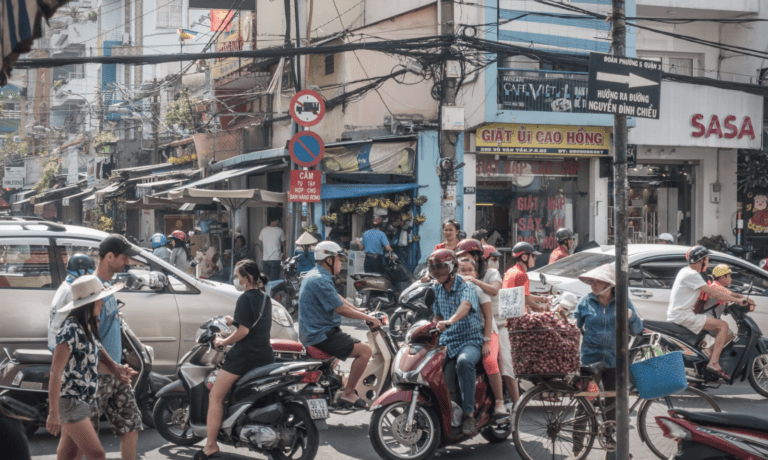The majority of people in the agricultural nation of Vietnam make their living by working on farms. Vietnamese people still operate local traditional businesses that date back many generations and employ ancient but reliable traditional equipment, in contrast to emerging nations on Earth.
You ought to visit rural areas in Vietnam as a foreign traveler. There are many genuine local experiences waiting in those less-touristy locations. Maybe you’re wondering right now how to go about doing it. Here are the Top 15 Activities In Vietnam Rural Villages To Embrace The Traditional Works Of Locals
1. Harvesting rice is one of those common local traditional works in Vietnam
In Vietnam, rice is essential. From ancient times, it has been a staple dish for all Vietnamese people. Long-spreading rice fields with white cranes may be found everywhere you go as you travel the length of the nation, especially in deltas. Vietnamese has a saying that describes how vast the field is: “A crane is too fatigued to continue its voyage.”
It’s time to harvest when you see the field in its full golden hue. Several diligent and shrewd farmers have been observed kneeling and using a specific knife, known as a “cái liềm” in Vietnamese. Ask them to test out and feel free to talk! That will undoubtedly be a unique yet fascinating event in your life, we are confident.
Under hot sunshine, your task is to work quickly to finish all the rice fields as fast as possible. That’s so difficult, right? Well, then you know how strong and skillful Vietnamese people are.
2. Get dirty (or muddy) in the field
Although rice is the predominant cereal in Vietnam, not all crops are rice-based. There are more types of crops than you may imagine, including fruit, maize, greens, and herbs. Local farmers must put in a lot of work to care for and grow them thrivingly before harvest.
We strongly advise trying out becoming a genuine farmer in Vietnam if you aren’t frightened of muck and grime. You may decide whether to rank, sow rice, grow vegetables, water crops, harvest, or engage in other farming tasks.
As Vietnamese people prefer to work their farms using traditional ways, you’ll notice that the majority of tasks demand your manual labor to complete. While it appears fairly rudimentary, that is exactly how local folk artworks are made.
3. Raise cattle like a local
What do parents in your nation say to kids who are too indolent to study?
Vietnamese parents typically tell their children, “If you don’t study harder, we will send you to remote communities and herd cattle instead,” or something like.
That conversation dates back to a time of extreme hardship. In the past, children were required to perform a lot of difficult tasks, such as tending cattle, to assist parents make ends meet. The unfortunate children from that tough time are now parents. They just advise their kids to recognize the consequences of being lazy and to work more in school. Other than that, the mental images of raising cattle were so innocent and happy.
Currently, not many kids are forced to work instead of attending school. When they have leisure time, their parents only permit them to care for such creatures. Such children ought to be given the title “expert of the land,” which is deserving. They are quite knowledgeable on a variety of topics, including where to find plenty of tasty wild fruits, where to go for exciting activities, and more.
In many of Vietnam’s remote communities, you may still discover the Vietnamese childhood. Forget about all of those grownup concerns, just let your spirit think like a child! Suddenly, everything quickly comes to life before your very eyes.
4. Go fishing on the river
Imagine working as a fisherman in Vietnam. It’s a good concept, after all.
Vietnam features a complex network of rivers and lakes because of its tropical climate and topography. Because of this, aquaculture has been growing incredibly well throughout the nation.
Vietnamese fishermen are skilled professionals with a variety of unique tactics for catching large fish. In other places, locals spend their whole lives on boats. You may assume that such savvy fishermen would never divulge their trade secrets to total strangers. They are really nice and will show you everything else they have.
A fisherman will employ a variety of techniques on a small boat, including a fishing rod and net. Besides learning to catch fish, don’t forget to try controlling the boat with paddles. Those activities require a lot of patience and effort. You will see time seems to slow down and each moment is full of joy and peace.
5. Catch big fishes from the ocean
Do you desire something more exciting and risky? Let’s try our hand at ocean fishing!
By making this decision, you embark on a quest to discover amazing things. As you follow a bunch of Vietnamese fishermen, you will “wow” at the magnificent sight you will see: it is incredible how little humans can manipulate nature. They are powerful, intelligent, and brave. They can alter their ship and net to avoid risks and acquire a significant catch.
The threats increase as the ship travels farther.
When the outcome is exactly what they anticipated, you will notice a brightening in their eyes. If not, they would lose a lot of cash that might have been used to pay their jobs and for gas. Life is like that.
In spite of the sadness, the fisherman will never give up on his local traditional works. After this failure, they will come home and prepare for a new journey, in the hope of a promising catch on the next trip.
6. Make various fermented sauces from seafood
The greatest method for preserving a sizable quantity of large catch is salt-heavy fermentation. For a very long time, people have utilized the conventional approach. Certain fermented foods, in particular, taste better after the procedure.
Locals in Vietnam refer to fermented seafood sauces as “mmm”. A specific name relies on the unusual ingredient(s). A few examples of fermented sauces are “mắm nêm” (fermented fish), “mắm mực” (fermented squid), and “mắm ruốc” (fermented little shrimp).
Many international visitors can’t stand the strong (often foul) aroma of all of those sauces. Also, the natives consider them to be quite appetizing. Just like some unique foods on earth (namely stinky tofu and blue cheese), you might need to try and get used to it to enjoy it pleasantly.
7. Become a real hunter in the forest
People still have a strong reliance on nature in nearly isolated highland locations. To hunt wild animals, herbs, spices, and vegetables, they typically travel to the forest. These unique goods assist villagers in enhancing their everyday diets, curing illnesses, and making a little money on the local market.
It’s a strange notion, but we know you’ll adore spending the day hunting with locals! To defend yourself from several unforeseen risks in the forest, you should be well-prepared with both your clothing and equipment. Don’t act like a native in simply regular clothes since they all know how to avoid risks!
You are ready to discover the variety of the Vietnamese tropical jungle on this exciting tour. Also, it’s a fantastic opportunity to observe the local hunters’ deft maneuvers up close. They are cunning in their trap-setting, climbing, and fast movement even on rough, treacherous terrain. They can pick up on even the slightest, most subtle signals since their eyes and hearing are so keen. Locals use that method daily to acquire as many things as they can.
8. Learn how to make rice paper
In Vietnamese food, rice paper may be found in both appetizers and side dishes. Would you want to practice producing rice paper in a local home? When you return home, perhaps you can launch your own company!
Rice, water, and salt are the only simple elements required to manufacture Vietnamese rice paper (some recipes have coconut milk, sesame seeds, sugar, banana slices to create special flavor). Every local uses a different ratio to combine those components.
A unique steamer is placed on top of a stove with high heat. The rice mixture must be added to the surface of the steamer, allowed to cook, removed, and then repeated. After taking fresh steamed rice papers out, people put them on bamboo racks and dry them out in the sun. That’s all what locals do!
Easier said than done! You might find those simple steps are so hard to handle. Don’t give up, practice makes perfect, right?
9. Take part in coffee making in Tay Nguyen rural villages
Coffee, more specifically iced coffee, is one of the most well-known and delicious beverages in Vietnam. Have you ever pondered the process of making anything from scratch? Why don’t you come in and learn about yourself to receive the greatest response?
Vietnam’s Central and South both have several locations where coffee trees are grown, particularly Tay Nguyen. Ask a native to let you see them make coffee if you ever get the chance to visit that place.
Fresh coffee fruits may be removed off the trees in one of two ways: by hand-picking each one or by simply dragging them into a big underground mesh. Fresh coffee fruits are then put through a number of processes (such as fermenting, drying, roasting, and grinding) to turn them into coffee powder and beverage. All steps and the history of coffee making will be shared by locals during your journey.
10. Learn how natural sea salt is made

Everyone is aware that sea salt is produced from saltwater, but few people are aware of the exact steps involved. Well, spending a day on a Vietnamese salt farm will provide you with the finest response.
Vietnam’s coastline is home to unique areas that are entirely white and devoid of any vegetation. Locals gather and crystallize sea salt there.
Salt crystals reflect sunlight and provide an eye-catching flashing effect when exposed to the sun. Rubber gloves, boots, conical hats, facemasks, and heavy clothing are required for workers. They may shield themselves from the savage heat of the sun and salt in this way. You will realize that the more gorgeous sea salt appears, the more hardships farmers must go through.
11. Make rice liquor with locals
We must note that rice liquor, often known as “rượu,” is the traditional alcoholic beverage in Vietnamese culture. Locals can be found consuming the beverage at all times, all across the nation. It is made of rice, a staple cuisine in Vietnam.
There are several ways to make rice in each part of the nation. Generally speaking, yeast is required for the fermentation to begin. It takes the right amount of time for cooked rice to ferment into alcohol. The well-fermented rice is then added to a large pot for distillation to produce the rice liquor. How dare you take a sip of that brand-new “rượu”?
12. Get to know how a Vietnamese traditional ethnic costume is made
You might not be aware that there are 54 different ethnic groups living peacefully together in Vietnam. Each ethnic group has its own language, culture, and dress. As a result, you are welcome to attend a variety of free unique fashion exhibits in highlands and rural markets.
There are a large number of traditional clothes since there are more than fifty different ethnic groups. Each article of clothing has unique details, such as structures, patterns, borders, colors, etc., if you look at them closely.
Often, young local women are required to learn how to sew traditional costumes. The length of time it takes to complete the task depends on how complicated it is (from several weeks to several months).
To know how Vietnamese ethnic women make their traditional costumes, you can visit country markets or their villages. They might be shy at first but then willing to show you generously.
13. Raise fish in the Mekong Delta
The Mekong Delta is a sizable region with intricate networks of canals, lakes, and rivers. You’ll be astonished to learn that residents raise fish beneath their homes. Very peculiar!
You should go to a local’s floating house to learn more about that unique technology. To feed their fish, the farmer must lift a board from the ground. Many of them can be seen opening their jaws in anticipation of food. Also, you will be shocked once more to learn that the natives create their own fish food.
14. Sell products in the market
Farmers in Vietnam’s remote areas continue to sell their goods in the market in order to make money. It is a unique quality for tourists from other countries. Want to know what it’s like to sell your freshly picked goods like a local?
Try to go to the market with the farmer if you have more time in Vietnam. To ensure you don’t lose the opportunity, you must first ask them. Typically, Vietnamese markets open early in the morning. Hence, you must get up earlier to prepare if you intend to offer fresh veggies or street cuisine.
If your items may be fully or partially sold out, you will be pleased and at ease. Yet, that will be very depressing. It’s not unusual when people bargain in Vietnam. They don’t even buy after a long haggle. All of those feelings and experiences help you embrace the traditional works in Vietnam better.
15. Cook an authentic Vietnamese daily meal
After a hard-working day, people deserve a good meal. Rural residents usually cook side dishes with available ingredients at home, especially vegetables and herbs. You just need to go out to the garden and decide what your favorite items are today. Plus, some farmers use leftover selling products to prepare their meals.
The way Vietnamese people cook is far more different from that in your country, right? Many locals still use wood and straw to make fires. The ingredients in a dish are significantly simple, too. In spite of the simplicity in the meal, you will find a cozy feeling of home. All members of the family sit back, eat, and share their stories in a day to each other.
Conclusion
In the magnificent nation of Vietnam, there are countless opportunities for happiness and adventure. The best method to have a thorough understanding of a typical Vietnamese farmer’s day is to visit rural areas to learn more about those regional traditional crafts.
You will get the greatest intimate experiences of Vietnamese country life throughout every minute that you stay with a family. Your information and perception are completely genuine and free of tourist traps. Just from the bottom of my heart, really.
Do you want to know how to create the ideal strategy to engage in all of those fascinating activities mentioned above? How about some excursions that are specifically tailored to your interests and availability? Contact Us so that we may assist you with all of our love and enthusiasm.


